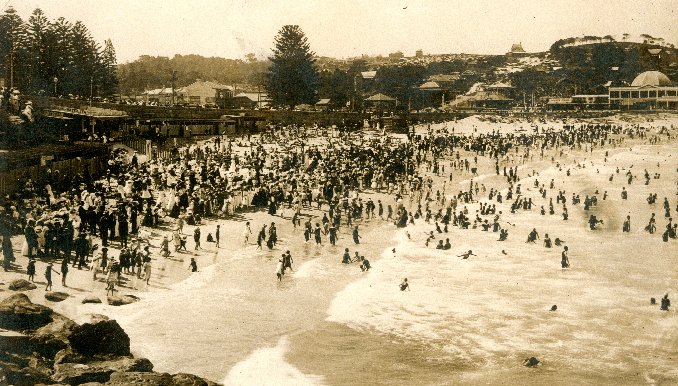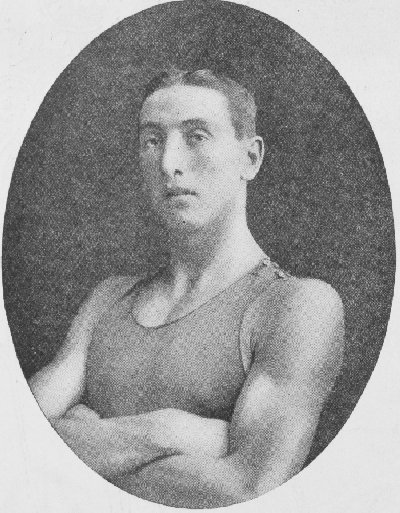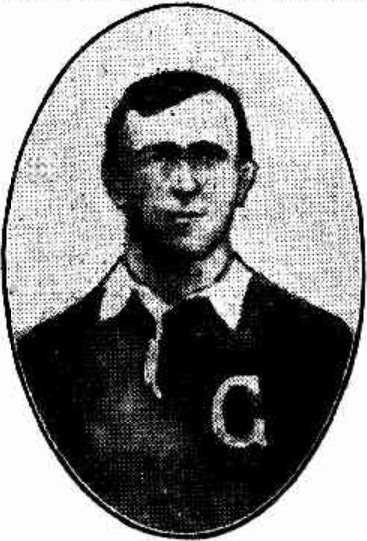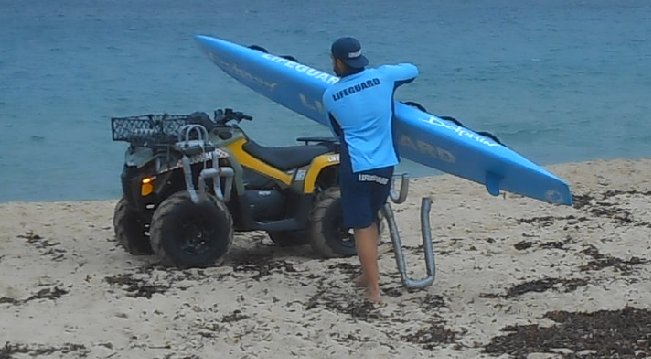
Busy day at Coogee Beach c1910
HISTORY | STORIES | BEYOND | |
BLOG | & CREATE | PEOPLE |
At about midday on Saturday 28th January 1911, dangerous surf conditions at Coogee swept a crowd of young swimmers out to sea, all in danger of drowning. Two volunteer lifesavers on the beach at the time, Harold Baker and Jim Clarken, bravely entered the surf to save as many as they could. Tragically, at the end of the day, they could not reach everyone and five young surfers lost their lives.

Storms Create Dangerous Conditions
Heavy rain had lashed Sydney's eastern suburbs in the preceding week. Large volumes of stormwater had emptied onto Coogee Beach, cutting a deep channel in sand just
underneath the breaking waves. As a result, a dangerous fast-flowing rip was pulling water away from the beach. Any swimmer there was in danger of being swept out to sea.
Earlier in the day, Harold Baker placed a red flag as a danger sign on the beach in front of the rip, warning swimmers to avoid the area. (see Note 1, below)
Back then, Saturday morning was one of the busiest work and shopping times of the week with businesses open till midday. Common practice was for people to start coming to the beach in the afternoon. Volunteer lifesavers, who would also normally at thier place of business in the mornings, tended to start patrols in the early afternoons. As it was, a large contingent of the volunteer life-savers had left Coogee to attend a surf-carnival at another beach. Even so, there were still about 100 people on the beach.
Luckily Harold Baker was the proprietor of the dressing sheds and refreshment stall on the beach and it was his normal practice to be on hand. Jim Clarken, another trained lifesaver, happened to be shopping in Coogee and called down to the beach to meet Baker. While they were leaning on a railing talking and watching the surf, they noticed a group of young people preparing to enter the surf near the rip. They both jumped onto the sand and ran towards the surfers, shouting, with the aim of warning them to move along the beach.
Too Late!
Too late! The swimmers had already entered the water by the time Baker and Clarken were in earshot. The rip had quickly swept them up and they could be seen frantically waving for help beyond
the breakers. Baker plunged into the surf, fully clothed, and quickly reached the group. Panicking, a young woman grabbed at Baker threatening to pull them under the water and drowning both.
Baker resorted to "slugging" her into submission and managed to drag her into shallow water where other swimmers pulled her ashore. Baker then pulled off his clothes and swam
back to see who else he could save. Three young women immediately grabbed him, again threatening to drown the whole group.
Meanwhile Jim Clarken had raced to the surf reel and wrestled the line away from onlookers who had entangled it, inexpertly trying to launch a rescue attempt. After a few shouted instructions to some helpers, he too plunged into the surf and headed out to those in distress. Reaching Baker with the line, he was able to have the three girls pulled into shore.
Heroic Efforts
Baker set out again for the third time, about 200 metres, where he was able to grab another girl, placed her on his shoulders and swam to shore with her. Clarken also swam out beyond the
breakers, rescuing more of the young women, one of whom gripped him so tightly in panic, Clarken also had to resort to "slugging" her in order to save her.
In all they made three journeys back and forth in the surf to save potential victims and between them they managed to rescue nine or ten people. At some stage, Baker was trying to revive one of the drowned victims, and was told there was still someone struggling in the water. He set out again to save this person, but in vain, the person was already deceased. This incident seemed to weigh heavily with Baker: had he not wasted time on trying to save someone already deceased, he may have saved another life.
Five Drowned
Every one of the young women were saved by Baker and Clarken, but four victims were a boy and three young men: Joseph McGrath (25), a tramway labourer
from North Sydney, George Mackle (28) a tramway conductor of Trafalgar Street, Petersham; David Andrew Wilson (9) of Luke Street, Coogee; and 12 year old Sydney Hardy of Belmore Road, Randwick.
Hardy's body was not recovered.
The surf evidently claimed a fifth victim. Clothes found near the men's baths were identified as those of J. J. T. Holt, a cadet on naval the training ship Medway, who went missing from his vessel from that fateful Saturday afternoon of the tragedy.
Harold Baker
William Harold Baker was born on 29 September 1887 in Sydney. He was a notable swimmer, winning three New South Wales championships in 1906 and captaining the Australian water polo team. He played Rugby
football for Australia three times against New Zealand and won boxing and wrestling championships. With his brother "Snowy" Baker (then a well-known Sydney sporting celebrity and later a Hollywood
film actor and producer), he worked for Stadiums Limited and refereed many of Les Darcy's most important fights, including the one against Fritz Holland on 12 September 1914 when he disqualified Darcy
for a foul. He was described as a 'man with a marble mouth and a jaw of steel. A man of ice
with frozen eyes and a frozen voice'. He was the captain of Maroubra Surf Club in 1900-10, and had taken part in rescues of other people prior to the 1911 incident.
He died on 17 October 1962 at Woollahra, survived by a daughter and by his wife Nellie Innes Sara, nee Crawshaw, whom he married on 12 June 1912.

Jim Clarken
Jim Clarken was born in Auckland, New Zealand. Born c.1876, he was a rugby footballer for the Glebe Club and worked as a tram driver . When he enlisted in the Australian Army in April 1915, his occupation was described
as being a 'motor mechanic'. He died on 31 July 1953, and after a service at St Brigid's Catholic Chruch was buried at Randwick General Cemetery in the Roman Catholic section M, plot 44. In 1911 he was living in the inner-city suburb of Pyrmont, but at the
time of his death he was living at 37 Arcadia Street, Coogee.

Recognition as Heroes
The Royal Shipwreck Relief and Humane Society awarded gold medals and certificates of merit to Baker and Clarken for their life-saving efforts. A public subscription for them raised £1000 in its first week.
They were feted as heroes and a big celebration was held in their honour at the Coogee Bay Hotel.
Repercussions
To our knowledge, this was the largest loss of life on Coogee Beach. Despite some claims that Baker and Clarken gave preference to rescuing the young
women, reports from the inquest seem to suggest it was just happenstance that they reached the women first. At times they tried to reach the boys, but they disappeared into the waves before they
could be reached. Remarkably there was criticism of Harold Baker for discarding his heavy wet clothing and being naked during the rescue! To make matters worse, while he was saving lives Baker's kiosk had been burgled
by some heartless individual.
There was also criticism for the paucity of volunteer life-savers on the beach at the time; many had traveled some distance to a surfing competition at North Style beach. But the surf life saving movement was still in its infancy and as noted earlier, Saturday mornings was still considered a time or business rather than recreation. Even the practices we recognise today as warning signals had not been standardised. Baker had apparently erected the red warning flag on his own initiative. Some even felt there should have been more warnings.
Professional Lifeguard Service
The employment of professional lifeguards at Randwick's beaches (and Coogee in particular) dates from the experience of the January 1911 tragedy.
Baker operated the dressing sheds and "other conveniences" on a leasehold from Randwick Council. In the aftermath of the tragedy, in March 1911, Council in response to agitation for permanent
life saving patrols to be stationed at the beach, considered employing a professional lifeguard. One faction, headed by Alderman Baker (apparently no relation to Harold) proposed to accept Harold
Baker's assurance that either he or a suitably qualified assistant would always be available while his dressing sheds were open. Others, however, wanted a professional lifeguard employed directly
by Council as well. In the end the Council decided to employ a professional lifeguard supplemented by the volunteer activities of the Surf Life Saving Club.

References
Note 1 : There was no standard for flag signage on beaches until the the 1930s. Before that some beaches used flags composed of local club colours to show that a beach was patrolled by lifesavers. Other flags were also used including, for instance, checkered flags.
In 1924, a signage system was developed for patrolled beaches with a system of blue and white flags to mark safe swimming areas, red flags to warn of dangerous areas, and signs with the words "SAFETY FIRST". Blue and white flags generally indicated to "swim between the flags" from 1924 to 1935. The blue and white patterns can still be seen today in the uniforms and colour motifs of the professional lifeguards employed by Randwick City Council.
1935 saw the introduction of the red and yellow flags, which were initially diagonal. This is related to the semaphore maritime flag system established in 1855 to communicate from ship to ship or ship to shore. The red and yellow flag is the signal for danger or a person overboard, also “O” in the flag alphabet. The diagonal red over yellow flag was still being used on Coogee Beach at least into the mid-1980s.
In 1980, in conjunction with the Standards Association of Australia, there was an agreement between SLSA and the Standards Association of Australia to adopt a change from the red and yellow quartered flag to a red over yellow parallel flag. This is the flag you will see today on patrolled beaches in Australia. The red over yellow pattern has been adopted by volunteer Surf Life Saving Associations as the colours for uniforms, logos, and other identification needs. The red over yellow flag is commonly used on patrolled overseas beaches, but is not always the case. Sometimes checkered flags are used, and combinations of red, green and yellow warning flags. Often two national flag s are used leaving one to wonder if that means to swim between the flags, or is it just a national holiday.
Copyright © Coogee Media All rights reserved
|
|
| CONTACT US | ABOUT US |